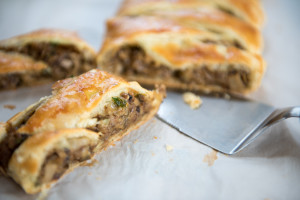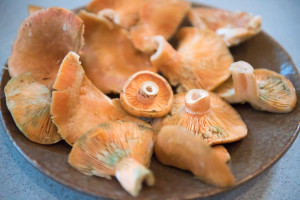 THE SAFFRON MILK CAP is a wild mushroom that most pot hunters leave to the Russians. That’s too bad because it’s tasty and abundant.
THE SAFFRON MILK CAP is a wild mushroom that most pot hunters leave to the Russians. That’s too bad because it’s tasty and abundant.
Saffrons, or ryzhiki in Russia, are actually a complex of species in the Lactarius genus, and much DNA work needs to be done to separate the North American varieties. They’re called milk caps for a latex they exude when cut. Some milk caps bleed white, some yellow, others red or orange.
Eastern Europeans have admired saffron milk caps for eons. I see Russians and Ukrainians in the woods outside Seattle carrying baskets overflowing with saffrons while their competition from other parts of the world is only too happy to leave the milk caps in the duff and fill their own buckets with matsutake or hedgehogs.
Saffrons bleed red or orange. The two most common saffrons for the table are Lactarius rubrilacteus and L. deliciosus (again, these taxonomic names are likely to change with future genetic testing). Both will bruise a greenish color (see photo above), which vanishes with cooking. I found the saffrons pictured here at about 4,000 feet in the North Cascades on the edge of an old-growth forest of mostly silver fir and hemlock amidst a few patches of snow on the ground. They bled a reddish-orange color (see photo below right), though not profusely, and the green bruising was minimal. Saffrons generally have zonate caps (concentric bands in varying hues of orange, pink, red, or green) but these rings were very subtle in my specimens. As you can see, they also had hollow or partially hollow stems.
Perhaps one of the reasons many pot hunters don’t eat saffrons is the difficulty of identifying to species. With most mushrooms that’s a no-no—and I’m still not sure exactly what species the pictured saffrons are, though L. aestivus is a good guess.
Saffron milk caps are versatile in the kitchen. Pickling is popular among Eastern Europeans. Sautéed, saffrons keep their salmon color and firm, almost crunchy texture. Some complain of graininess, but prolonged cooking eliminates this. The key to using saffrons is taking care of them in the field and then using quickly at home. These mature milk caps pictured, though completely bug-free, were more suitable for the pan than pickling due to their large size. The green bruising isn’t appetizing, but as I said, it disappears with cooking.
Recently I came across a mushroom cookbook with some excellent non-cheffy recipes for the home cook, The Edible Mushroom Book. The recipe that follows is adapted from that with a few tweaks.

Pan-fried Chicken with Saffron Milk Cap Ragout
3 – 4 chicken thighs, skin on
1/2 lb saffron milk caps, cut up
2 shallots, diced
1 – 2 cloves garlic, crushed
2 tbsp vegetable oil
2 tbsp butter
1 cup white wine
1 cup chicken stock
1/2 cup heavy cream
2 – 3 fresh sprigs fresh thyme
salt and pepper
1. Pre-heat oven to 400 degrees. Pat dry chicken and season with salt and pepper. In a medium saucepan, heat oil over medium-high and pan-fry, skin side first, until golden, a few minutes on each side. Remove to an oven-proof dish and continue cooking in oven until juices run clear, about 20 minutes.
2. In same saucepan, melt butter and sauté diced shallots until soft and translucent. Add mushrooms, thyme, and crushed garlic and continue cooking together a few minutes. Season with salt and pepper.
3. Deglaze pan with white wine and reduce by half. Add stock and heavy cream and reduce until desired consistency. Spoon mushroom sauce on plates and then place chicken atop sauce.
Serves 2

Like this:
Like Loading...
 I had the pleasure of sitting down recently with Eric Parkinson, of This Must Be the Place, a podcast that seeks to reveal “the unique physical, cultural, and emotional layers of places.”
I had the pleasure of sitting down recently with Eric Parkinson, of This Must Be the Place, a podcast that seeks to reveal “the unique physical, cultural, and emotional layers of places.”

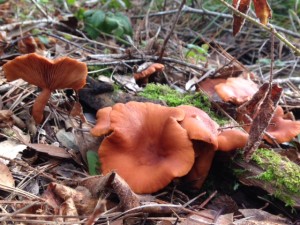 CANDY CAPS ARE a complex of species in the milk cap genus, Lactarius. They’re noteworthy for smelling of maple syrup once dried, effectively putting mushrooms on the dessert menu. Two species of candy cap are commonly encountered in coastal California: L. rubidus and L. rufulus. The latter grows with oaks and is quite mild, but the former—if dehydrated at a low temperature (I think we set our dryer to 95 degrees)—is wonderfully fragrant. We found hundreds of them recently growing among a stand of old Monterrey pines.
CANDY CAPS ARE a complex of species in the milk cap genus, Lactarius. They’re noteworthy for smelling of maple syrup once dried, effectively putting mushrooms on the dessert menu. Two species of candy cap are commonly encountered in coastal California: L. rubidus and L. rufulus. The latter grows with oaks and is quite mild, but the former—if dehydrated at a low temperature (I think we set our dryer to 95 degrees)—is wonderfully fragrant. We found hundreds of them recently growing among a stand of old Monterrey pines.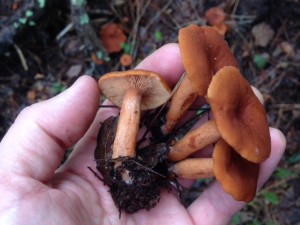 1 small handful dried candy caps
1 small handful dried candy caps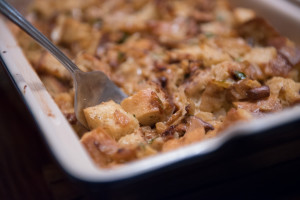 THIS TOTALLY UN-FUSSY bread pudding shines with a medley of wild mushrooms.
THIS TOTALLY UN-FUSSY bread pudding shines with a medley of wild mushrooms.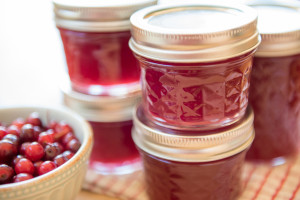 THE
THE 

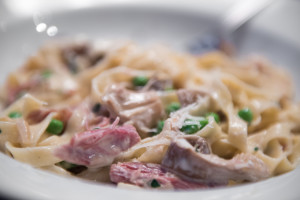 I’VE MADE PLENTY of Asian-style dishes with wild oyster mushrooms, like
I’VE MADE PLENTY of Asian-style dishes with wild oyster mushrooms, like 
 I’m happy to report that my article “Into the Woods” for
I’m happy to report that my article “Into the Woods” for  The spring foraging season is just around the corner. I’m partnering with
The spring foraging season is just around the corner. I’m partnering with 




